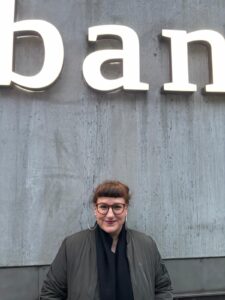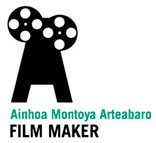
Über mich
Ich wurde 1973 in Bilbao, Spanien, geboren. Mit 13 Jahren zog ich mit meiner Familie nach Madrid. Dort studierte ich Medienkultur an der Universidad Complutense.
1998 zog ich nach Hamburg, wo ich die deutsche Sprache und Lebensrealität kennenlernte. Ich erlernte den Beruf der Filmvorführerin und arbeitete im Passage-Kino – dem ältesten Kino Hamburgs und einem der ältesten Kinos Deutschlands.
Nach kleineren Projekten und Kooperationen entstand 2003 mein erster Kurzfilm „Krieg®“.
2006 stellte ich meinen ersten dokumentarischen Langfilm fertig:
„Die vergessene Generation – Die erste Generation Spanier/innen in Hamburg“, realisiert im Rahmen eines Aufbaustudiums an der Hochschule für bildende Künste Hamburg (HFBK).
2008 folgte mein zweiter Dokumentarfilm:
„HOTEL MIGRATION – Auf Reise Richtung Rente“.
2011 wurde mein dritter Dokumentarfilm fertiggestellt:
„Auf vielen Stühlen – Ein Leben in Deutschland“.
2013 dokumentierte ich den für das UNESCO-Weltkulturerbe vorgeschlagenen Jüdischen Friedhof in Altona mit dem Film:
„Blicke in die Ewigkeit. Der jüdische Friedhof Altona“.
2018 entstand mein vierter Langdokumentarfilm:
„Kaminos de leche i miel – Sephardisches Leben in Istanbul“.
Ein Film über die sephardischen Juden in Istanbul und ihre Sprache – Judezmo (auch: Judenspanisch oder Ladino) – ein Porträt dieser türkischen Minderheit.
Seit 2021 leite ich das Projekt www.juedischesleben.wandsbek.de – eine digitale, interaktive Karte zum jüdischen Leben in Wandsbek, dem größten Bezirk Hamburgs.
Die Karte dokumentiert jüdische Orte, Biografien und Spuren eines einst lebendigen jüdischen Lebens, das während der NS-Zeit ausgelöscht wurde.
Wandsbek wurde im Zweiten Weltkrieg schwer bombardiert, wodurch die ursprüngliche Architektur und Stadtstruktur heute kaum noch erkennbar ist.
Dank der Fotografien von Jesco Denzel können die heutigen Orte jedoch auf der Karte sichtbar gemacht werden – als Brücke zwischen Vergangenheit und Gegenwart. Diese Spuren sind von großer Bedeutung für unsere Gesellschaft, um das Erinnern wachzuhalten und dem Vergessen aktiv entgegenzuwirken.
Im Rahmen des Projekts wird am 11. Mai 2025 im Abaton Kino der Dokumentarfilm „Grabe, wo du stehst – Gedenken und Erinnern in Wandsbek“ uraufgeführt. Der Film porträtiert drei Forscherinnen, die sich seit Jahrzehnten engagiert dafür einsetzen, die verborgenen Biografien von Opfern des Nationalsozialismus ans Licht zu holen – und dem Vergessen zu entreißen.
Mein Leben spielt sich zwischen Spanien und Deutschland ab.
Dokumentarfilme
Der Schwerpunkt meiner Arbeit liegt auf der Erforschung von Migration und der Konstruktion von Identität im Kontext migrationsbezogener Erfahrungen.
Der Dokumentarfilm ist das Medium, das meine Herangehensweise am besten ausdrückt – deshalb habe ich es zu meinem bevorzugten Ausdrucksmittel gewählt.
Meine Filme entstehen aus dem Wunsch, zur gesellschaftspolitischen Auseinandersetzung mit dem Thema Migration beizutragen – mit dem Ziel, Migration als integralen Bestandteil jeder menschlichen Gesellschaft begreifbar zu machen.
__________
About
I was born in Bilbao, Spain, in 1973. I moved to Madrid with my family when I was 13. There I studied media culture at the Universidad Complutense.
I moved to Hamburg in 1998, where I got to know the German language and the reality of life. I learned the profession of a projectionist and worked at the Passage-Kino – the oldest cinema in Hamburg and one of the oldest cinemas in Germany.
After smaller projects and collaborations, I made my first short film “War®” in 2003.
In 2006, I completed my first feature-length documentary film:
“The forgotten generation. The first generation of Spaniards in Hamburg”, realized as part of a postgraduate course at the Hochschule für bildende Künste Hamburg (HFBK).
My second documentary followed in 2008:
“HOTEL MIGRATION. On a journey towards retirement”.
My third documentary was completed in 2011:
“On many chairs – A life in Germany”.
In 2013, I documented the Jewish cemetery in Altona, which has been proposed as a UNESCO World Heritage Site, with the film: “Glimpses into eternity. The Jewish cemetery Altona”.
In 2018, I made my fourth feature-length documentary: “Kaminos de leche I miel. Sephardic Life in Istanbul”.
A film about the Sephardic Jews in Istanbul and their language – Judezmo (also: Judeo-Spanish or Ladino) – a portrait of this Turkish minority.
Since 2021, I have been leading the project www.juedischesleben.wandsbek.de – a digital, interactive map of Jewish life in Wandsbek, Hamburg’s largest district. The map documents Jewish places, biographies and traces of a once vibrant Jewish life that was wiped out during the Nazi era. Wandsbek was heavily bombed during the Second World War, making the original architecture and urban structure barely recognizable today.
Thanks to Jesco Denzel’s photographs, however, today’s places can be made visible on the map – as a bridge between past and present.
These traces are of great importance for our society in order to keep the memory alive and actively counteract forgetting.
As part of the project, the documentary “Dig where you stand». Commemoration and remembrance in Wandsbek will premiere at the Abaton Cinema on May 11, 2025.
The film portrays three researchers who have been committed for decades to bringing the hidden biographies of victims of National Socialism to light – and rescuing them from oblivion.
I live between Germany and Spain.
Theme
The focus of my work is on the exploration of migration and the construction of identity in the context of migration-related experiences. Documentary film is the medium that best expresses my approach – which is why I have chosen it as my preferred means of expression. My films arise from the desire to contribute to the socio-political debate on the subject of migration – with the aim of making migration comprehensible as an integral part of every human society.
__________
Sobre mi
Nacida en Bilbao en 1973, Estado Español. A los 13 años de edad me mudo con mi familia a Madrid. Curso mis estudios en la Universidad Complutense de Madrid, en la facultad de Ciencias de la Información. Tras haber acabado los estudios cambio mi residencia en 1998 a Hamburgo, Alemania, donde conozco el idioma, las costumbres y el trasfondo del lugar. Aprendo el oficio de proyeccionista en el cine Passage, uno de los cines más antiguos de Europa que aún continúa en actividad como cine. Tras distintas colaboraciones y pequeños proyectos realizo en el 2003 el cortometraje “Guerra®”.
En el año 2006 termino mi primer largometraje documental dentro del curso de postgraduado en la Escuela Superior de Arte de Hamburgo (Hochschule für bildende Künste, HfbK, Hamburg) “La Generación olvidada. La primera generación de españoles/as en Hamburgo”.
Mi segundo documental se estrena en el año 2008 “HOTEL MIGRACIÓN. Un viaje a la jubilación”. En el 2011 estreno la tercera película documental “Sobre varias sillas. Una vida en Alemania”.
En el 2013 realizo una larga documentación del cementerio judío de Altona en Hamburgo: Miradas a la eternidad. El cementerio judío de Altona. El cementerio judío de Altona es el más antiguo de Hamburgo y el cementerio sefardí-portugués más antiguo del norte de Alemania. Esta documentación es una gran herramienta para los investigadores, ya que grabamos cada lápida, cada tumba haciendo todo un mapa visual del areal.
En el 2018 finalizo mi cuarto documental «Kaminos de leche i miel. Vida sefardí en Estambul«. Un retrato de una minoría turca, una mirada a la identidad de este grupo. La película nos acerca a esta comunidad, a su historia y a su idioma judeoespañol conformando así una joya lingüística con los quizás últimos hablantes maternos de este idioma.
Desde 2021 dirijo el proyecto www.juedischesleben.wandsbek.de, un mapa digital e interactivo sobre la vida judía en Wandsbek, el distrito más grande de Hamburgo. El mapa documenta lugares, biografías y rastros de una vida judía que fue aniquilada durante la época nazi.
Wandsbek sufrió intensos bombardeos durante la Segunda Guerra Mundial, por lo que la arquitectura y la estructura urbana originales apenas son reconocibles hoy en día. No obstante, gracias a las fotografías de Jesco Denzel, los lugares actuales pueden representarse en el mapa, actuando como un puente entre pasado y presente.
Estas huellas tienen una gran importancia para nuestra sociedad, pues ayudan a mantener viva la memoria y a contrarrestar activamente el olvido. Como parte del proyecto, el documental «Cava donde estés: conmemoración y recuerdo en Wandsbek» se estrenó en el cine Abaton el pasado 11 de mayo de 2025.
La película retrata a tres investigadoras e investigadores que, desde hace décadas, se dedican a sacar a la luz las biografías ocultas de las víctimas del nacionalsocialismo y a rescatarlas del olvido. Su trabajo y el de muchas personas como ellos y ellas de barrio es la base de la llamada Cultura de la Memoria en Alemania.
Mi vida se desarrolla entre España y Alemania.
Tema
El tema central de mi trabajo es la documentación de la migración y la construcción de la identidad del sujeto dentro de ella. El medio documental es el que he elegido como el más adecuado para la realización de mi trabajo. El sentido que guía mis películas es el hacer mi aportación a los debates sociopolíticos entorno a la emigración, en un intento de entender este fenómeno como algo característico a cualquier sociedad humana.
